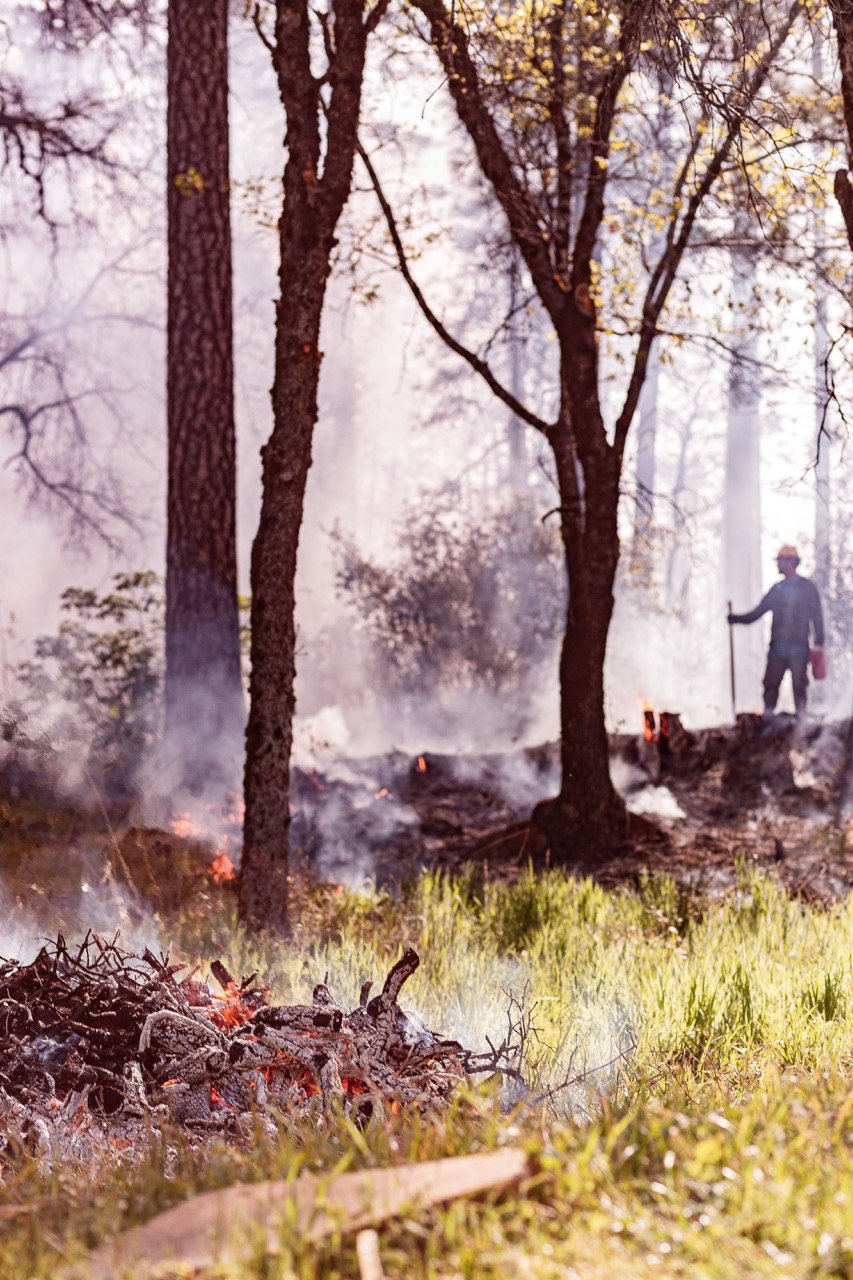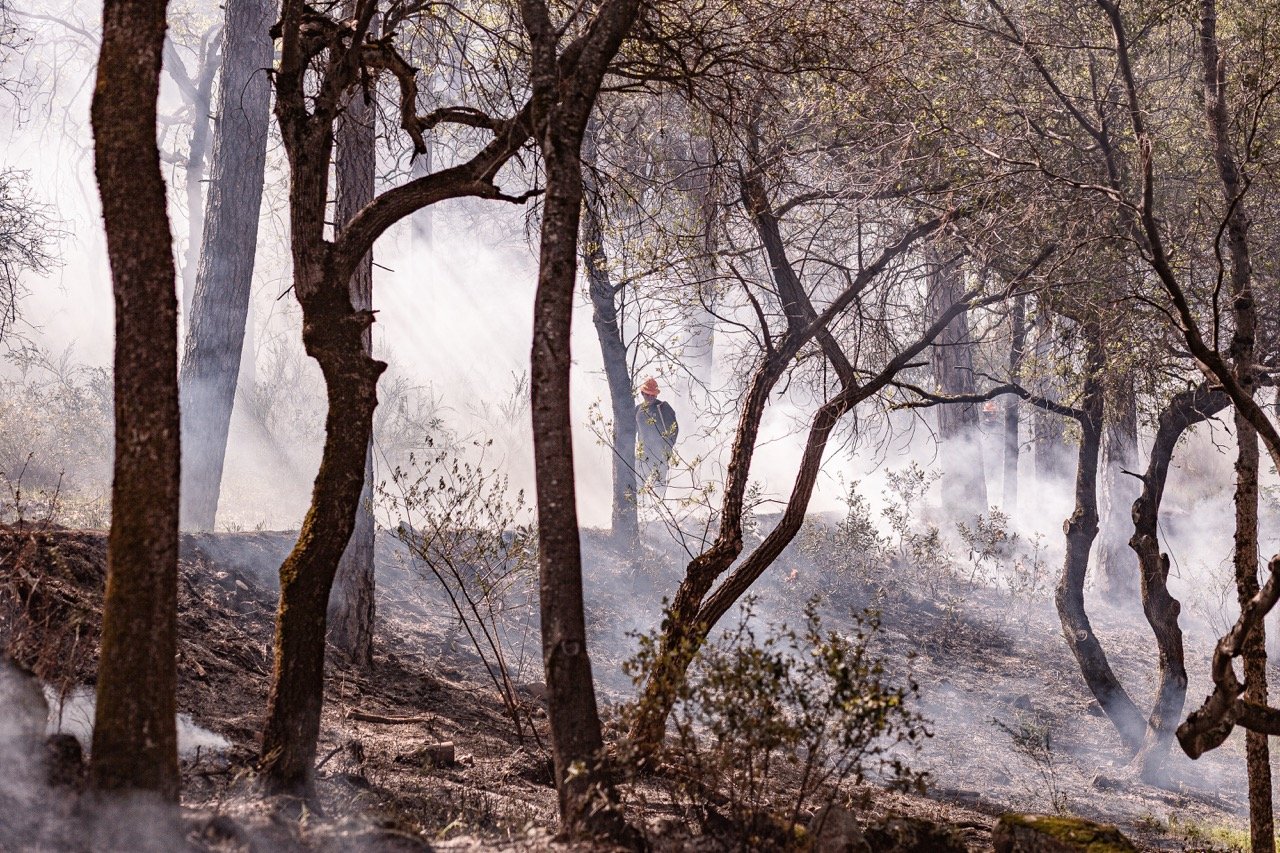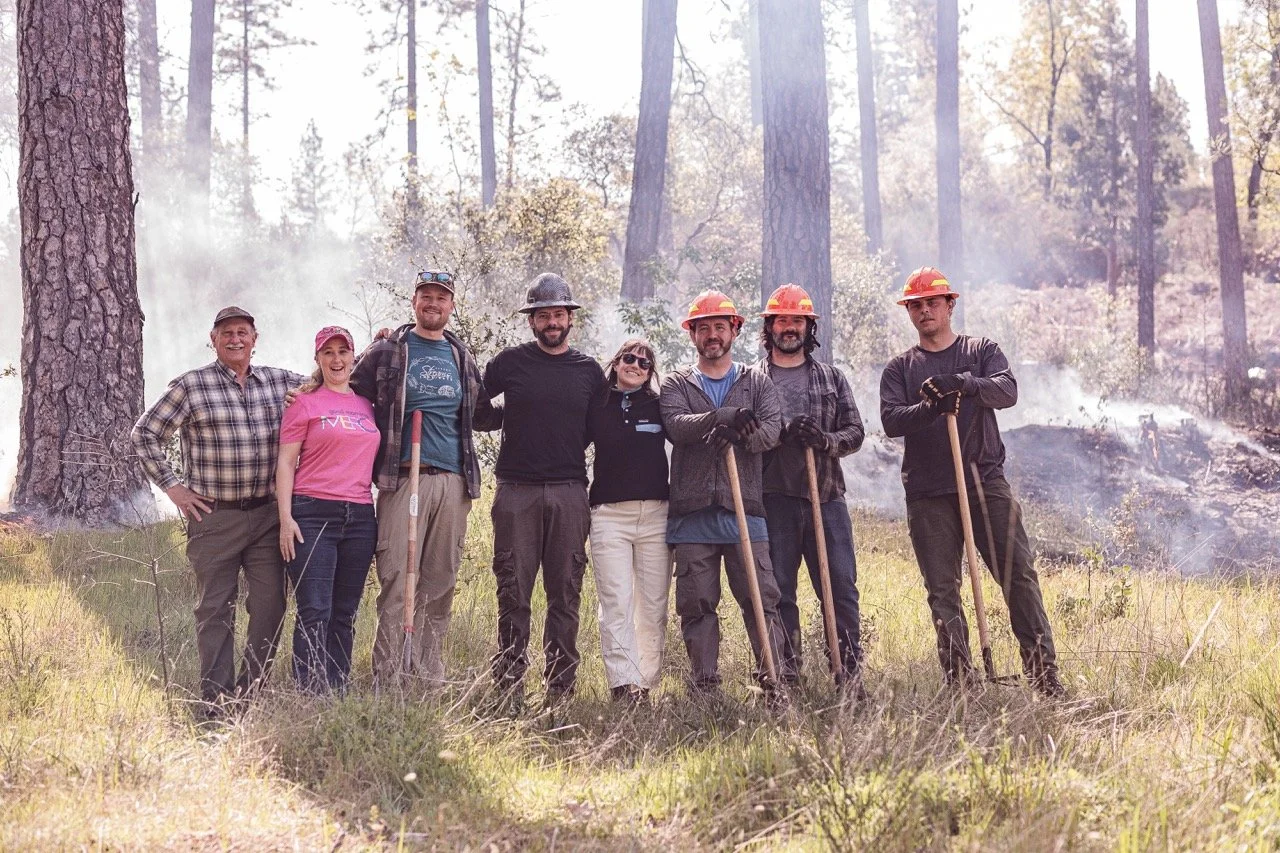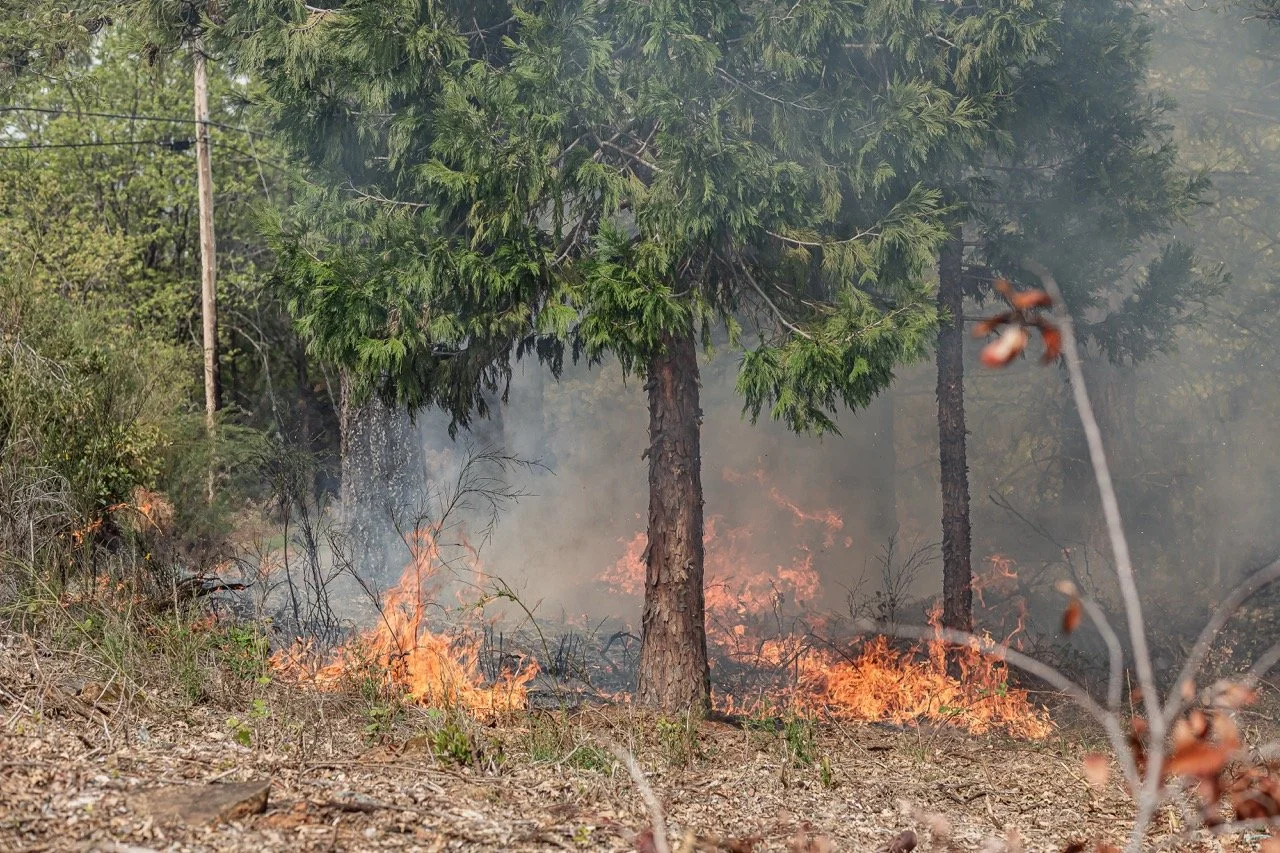
Tribally-Guided
Stewardship Crew
The Tribally-Guided Stewardship Crew is a key expression of CHIRP’s People and Land programming, which recognizes the symbiotic relationship between the health of the land and the well-being of the Nevada City Rancheria Nisenan Tribe.
The Stewardship Crew is restoring traditional stewardship practices on Nisenan Ancestral Homelands, using Indigenous Traditional Ecological Knowledge (ITEK) to protect, revitalize, and heal the land in ways that center Cultural priorities and long-term ecological resilience.
Tribally-Guided Stewardship Crew
CHIRP’s Tribally-Guided Stewardship Crew is an 8-person team composed of Nisenan Tribal members and local community members, trained together and united in their care for Nisenan Ancestral Homelands.
Since launching in Fall 2024, the crew has matured into a skilled and trusted workforce at the intersection of Cultural restoration and ecological resilience. The team’s certifications and training include:
Wilderness First Aid/CPR Certification
S-212 Basic Chainsaw Operation & Maintenance – Certified via SAIL Forestry
FFT2 Basic 40 Fire Training (includes FEMA 100, 700, and 200) – Certified by Danny Manning of Greenville Indian Rancheria
ITEK Field Training – Provided by Magan Herrera of Berry Creek Rancheria
Intermediate Chainsaw & Falling Technique – Certified via SAIL Forestry
Biochar Kiln Operation
In addition to the extensive training, the Stewardship Crew has partnered with the Sierra Streams Institute, The Sierra Institute for Community and the Environment, the Natural Resource Conservation Service (NRCS), Point Blue Conservation Science, Sierra Nevada Conservancy, California State Parks, Tahoe National Forest, City of Nevada City, PG&E, Nevada Irrigation District, as well as other Tribal entities including Berry Creek Rancheria, Konkow Valley Band of Maidu Indians, and Danny Manning, Assistant Fire Chief for Greenville Indian Rancheria.
Members of the Stewardship Crew and community supporters during the Koćim Pakan Culturally-informed burn demonstration. RoseFirePhotography
All partnerships are ongoing, underscoring the preparedness of the program to take on more restoration projects.
Continued funding allows the Stewardship Crew to expand the number of acres treated, deepen crew training, and sustain trusted relationships that support long-term contracts rooted in Cultural and ecological integrity.

Stewardship and True Conservation
The Stewardship Crew’s work dovetails with CHIRP and the Tribe’s broader environmental advocacy, including water stewardship, climate adaptation, and ecological restoration.
It embodies what CHIRP calls True Conservation: conservation that centers Indigenous knowledge and Cultural continuity in environmental restoration and resiliency work. By merging ancient Nisenan wisdom with adaptive and innovative land management practices, the Stewardship Crew’s work exemplifies what is possible when ITEK is not only remembered, but actively applied.
In this way, the Stewardship Crew models a living system of Tribal land care - one that blends Indigenous fire practices with modern tools and training to cultivate reciprocal healing between people and place.
Stewardship Process
CHIRP’s Tribally-Guided Stewardship Crew follows a multi-step, place-based approach to land stewardship that integrates Indigenous Traditional Ecological Knowledge (ITEK), environmental science, and long-term ecological care.
Each project is carefully tailored to the unique ecology and Cultural significance of the site, and incorporates ITEK into land prescriptions from the start, rather than an afterthought.
Culturally-Informed Land Prescription
Every project begins with the creation of a detailed prescription that identifies:
Which trees and plants are Culturally significant and should be protected
Specific land care objectives, such as invasive species removal, fuel load reduction, or habitat restoration
Ecological priorities for that particular location
These prescriptions are developed with Cultural advisors and ITEK practitioners to ensure they reflect the values and needs of the Nisenan People and the land itself.
Forester Consultation
The Stewardship Crew consults with Registered Professional Foresters to review and refine the prescription. This ensures that ecological best practices align with Cultural goals, and that regulatory and technical requirements are met.
Implementation of the Prescription
The Stewardship Crew then carries out work orders as defined in the prescription, including:
Creating healthy spacing between trees and shrubs with chainsaws
Removing limbs from trees that may act as ladder fuels with polesaws
Invasive species removal through cutting, hand pulling and weed trimming
“Cut and pile” or “cut and slash” techniques to prepare excess biomass for removal
Removal of Fuels
Once material is cut, the Stewardship Crew removes fuel using one of two methods:
Culturally-informed burns, including prescribed and Cultural burns
Chipping, when fire use is not feasible or appropriate
This step restores balance and reduces the risk of catastrophic wildfire while honoring Indigenous fire practices
Ecological Restoration
After fuel removal, the team actively works to restore native ecology by:
Seeding and planting Native species
Suppressing regrowth of invasive plants to support Native species in reclaiming dominance
Follow-Up and ReTreatment in 1 - 3 Years
Land stewardship is never one-and-done. Each site is revisited in 1 to 3 years to conduct:
Assessment of forest health and ecological success
Additional rounds of thinning, fire, or chipping as necessary
Re-seeding or planting as necessary
This commitment to long-term care is what distinguishes the Stewardship Crew’s work. It’s not just a treatment – it’s a re-establishing relationship with the land.
This continuity ensures that the work creates lasting ecological transformation, not just short-term visual change.
Community Re-Education:
Reintroducing “Good Smoke”
A core part of the Stewardship Crew’s mission is to educate the broader community about the Cultural importance of fire and the role of Indigenous Traditional Ecological Knowledge (ITEK) in forest health.
The Koćim Pakan Project at the Nevada City School of the Arts (NCSA) is a model of this vision in action. This site has hosted hands-on restoration efforts – fuel reduction, invasive species removal, and meadow rehabilitation – combined with intentional, Culturally-informed prescribed burns. The Stewardship Crew collaborates with educators and students on the ground, allowing youth to see what it means to care for land from a place of reciprocity and relationship, rather than control and suppression.
Community members during the Koćim Pakan Culturally-informed burn demonstration. RoseFirePhotography
In Spring 2025, the Tribally-Guided Stewardship Crew co-sponsored a public community education event at Koćim Pakan, attended by over 200 people. The event showcased what “good fire” looks like, with live demonstrations and a prescribed burn. These efforts help dismantle the fear-based narratives around wildfire, replacing them with Indigenous-led models of care, stewardship, and “good smoke” – smoke with purpose, history, and healing intent.
This type of immersive, place-based learning offers a powerful opportunity for re-education: fire is not inherently destructive.
In Indigenous hands, fire is medicine
Why This Work Matters
The return of Tribal stewardship brings more than ecological benefit – it is a powerful act of healing and reclamation. The Stewardship Crew:
Reintroduces “good fire” and “good smoke” to lands historically harmed by fire suppression
Restores relationships between Tribal People and land, reversing centuries of separation
Models ITEK-based forest management, inspiring agency partners to adopt Indigenous-informed prescriptions
Creates meaningful employment and skills development for Nevada City Rancheria Nisenan Tribal Members and local community members
Builds toward long-term systems change, influencing fire policy, land practices, and workforce development
This is not just wildfire mitigation.
This is the return of a way of being in relationship with the land that offers healing for the environment, the Tribe, and the broader community.

How You Can Support
This work is bold, sacred, and urgently needed – and your support matters.
You can uplift and amplify this vital work by:
Donating to CHIRP’s Ancestral Homelands Reciprocity Program (AHRP) to fund workforce development, tools, and training for the Stewardship Crew
Encouraging local agencies and landowners to contract with the Stewardship Crew for vegetation management, ecological restoration, and Culturally-informed fire services
Inviting ITEK into your community and advocating for partnerships that put Tribal Leadership at the center of land management decisions
Shifting your perception of fire by learning about Indigenous fire stewardship – support the return of “good fire”
Together, we can return balance to these forests, restore rightful stewardship, and ensure a healthier future for the land, its Original Stewards, and the broader Sierra Foothill community.



